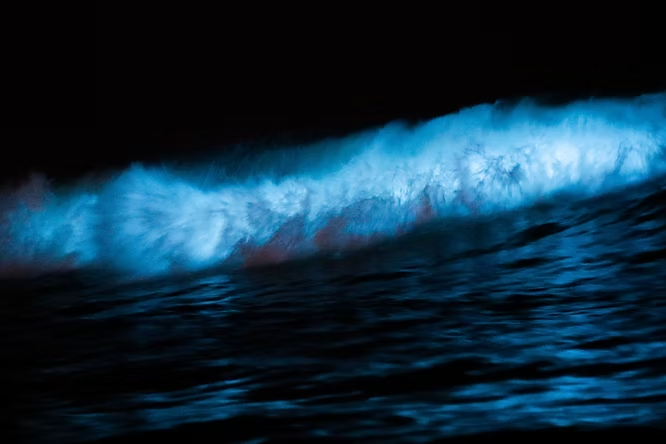The Magic of Bioluminescence
Whether it’s the Northern Lights in winter or fireflies in summer, natural light fascinates humans. In the ocean, bioluminescence creates some of the most breathtaking displays, with marine animals, plants, and microbes producing light through chemical reactions for survival, feeding, or reproduction.
Glittering Waves
Microscopic marine organisms, including thousands of dinoflagellate species, light up with even slight movement. These tiny plankton create sparkling waves or glowing boat wakes. The light can serve multiple purposes, such as signaling predators to stay away or attracting bigger predators to defend the tiny organisms, acting as a “bioluminescent burglar alarm.”
Lingulodinium polyedrum and Red Tides
This species has a circadian rhythm, producing light primarily at night. Red tides along Southern California and Mosquito Bay in Puerto Rico offer opportunities to see these glowing waters, which can be explored by kayak in the dark.
Seductive Beacons
In Bermuda, female fireworms rise after the full moon, swimming in circles while glowing to attract males. This nightly bioluminescent dance culminates in the simultaneous release of eggs and sperm, creating a mesmerizing underwater spectacle.
Symbiotic Light
Some animals rely on bacteria for bioluminescence. Hawaiian bobtail squid attract glowing bacteria to live in a light organ above their eyes. The bacteria gain a home and nutrients, while the squid uses the light to avoid predators.
Other Symbiotic Relationships
- Flashlight fish harbor glowing bacteria beneath their eyes, controlling the light with lids.
- Anglerfish use bioluminescent bacteria to lure prey.
- Pinecone fish light their bottom lip to attract food.
- Bacteria on dead organisms help deep-sea scavengers navigate in darkness.
Fireflies of the Sea
Firefly squid off Japan’s Toyama Bay produce blue light displays during spawning from March to May. Lined with photophores, they communicate, attract mates, and deter predators. Similarly, Caribbean ostracods light up and release glowing mucus to signal nearby mates.
A Coastal Light Show
Bioluminescent clams like Pholas dactylus bore into rocks along English and French shores, lighting the coast. These clams contributed to the discovery of luciferase and luciferin proteins in the 1880s, now crucial in genetic and biological research.
Deep-Sea Wonders
Over 50 percent of deep-sea organisms glow, but pressure prevents most human observation. Species like lantern fish, hatchetfish, and dragonfish display photophores along their bodies. In places like the Strait of Messina near Sicily, deep-sea creatures rise to shallow waters, offering rare glimpses of this luminous world. Submersible journeys reveal an otherworldly “sparkling stars” effect, a mesmerizing view of the deep ocean’s bioluminescence.

